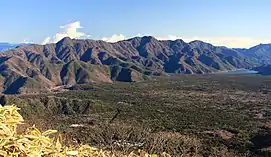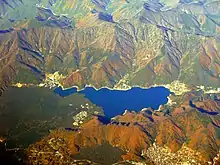| Aokigahara | |
|---|---|
 Aokigahara, the Misaka Mountains and Saiko Lake, as seen from Mount Ryu of the Tenshi Mountains | |
 Aokigahara Mount Fuji  Locations of Aokigahara and Mount Fuji | |
| Ecology | |
| Realm | Palearctic |
| Biome | Temperate broadleaf and mixed forest |
| Geography | |
| Area | 35 km2 (14 sq mi) |
| Country | Japan |
| Prefecture | Yamanashi Prefecture |
| Coordinates | 35°28′12″N 138°37′11″E / 35.47000°N 138.61972°E |
| Conservation | |
| Conservation status | Relatively stable/Relatively intact |
Aokigahara (青木ヶ原, 'Blue Tree Meadow'), also known as the Sea of Trees (樹海, Jukai), is a forest on the northwestern flank of Mount Fuji on the island of Honshu in Japan, thriving on 30 square kilometres (12 sq mi) of hardened lava laid down by the last major eruption of Mount Fuji in 864 CE.[1] The western edge of Aokigahara, where there are several caves that fill with ice in winter, is a popular destination for tourists and school trips. Parts of Aokigahara are very dense, and the porous lava rock absorbs sound, contributing to a sense of solitude that some visitors attribute to the forest.[2]
The forest has a historical reputation as a home to yūrei: ghosts of the dead in Japanese mythology. At least since the 1960s, Aokigahara has become associated with suicide, eventually becoming known in English by the nickname "Suicide Forest" and gaining a reputation as one of the world's most-used suicide sites. Because of this, signs at the head of some trails urge suicidal visitors to think of their families and contact a suicide prevention association.
Geography

The forest floor mostly consists of volcanic rock.[3] Designated trails lead to several tourist attractions such as the Narusawa Ice Cave, Fugaku Wind Cave and Lake Sai Bat Cave which are three larger lava caves near Mount Fuji, the ice cave being frozen year-round.[4]
Aokigahara has been falsely portrayed as a place where navigational compasses go haywire. Needles of magnetic compasses will move if placed directly on the lava, aligning with the rock's natural magnetism, which varies in iron content and strength by location. However, a compass behaves as expected when held at a normal height.[2] The Japan Ground Self-Defense Force has conducted its Ranger Courses including navigation training in the forest since 1956.[5]
Flora and fauna
Mammals include the Asian black bear,[6] small Japanese mole,[7] bats,[1] mice,[1] deer, fox, boar, wild rabbit, Japanese mink and Japanese squirrel.[8] Birds include great tit, willow tit, long-tailed tit, great spotted woodpecker, pygmy woodpecker, bush warbler, Eurasian jay, Japanese white-eye, Japanese thrush, brown-headed thrush, Siberian thrush, Hodgson's hawk-cuckoo, Japanese grosbeak, lesser cuckoo, black-faced bunting, oriental turtle dove, and common cuckoo.[8]
There are ground beetles and other insects,[1] including many species of butterflies, even in the forest interior Argynnis paphia, Chrysozephyrus smaragdinus, Celastrina argiolus, Celastrina sugitanii, Curetis acuta, Favonius jezoensis, Neptis sappho, Parantica sita and Polygonia c-album are found.[9]
The forest has a variety of conifers and broadleaf trees and shrubs, including Chamaecyparis obtusa,[9] Cryptomeria japonica,[10] Pinus densiflora, Pinus parviflora, Tsuga sieboldii, Acer distylum, Acer micranthum, Acer sieboldianum, Acer tschonoskii, Betula grossa, Chengiopanax sciadophylloides (as Acanthopanax sciadophylloides a.k.a. Eleutherococcus sciadophylloides), Clethra barbinervis, Enkianthus campanulatus, Euonymus macropterus, Ilex pedunculosa, Ilex macropoda, Pieris japonica, Prunus jamasakura, Quercus mongolica var. crispula, Rhododendron dilatatum, Skimmia japonica f. repens, Sorbus commixta (as Sorbus americana ssp. japonica) and Toxicodendron trichocarpum (as Rhus trichocarpa).[9] The dominant tree species between 1,000 and 1,800 metres of altitude is Tsuga diversifolia and from 1,800 to 2,200 metres is Abies veitchii.[10]
Deeper in the forest there are many herbaceous flowering plants, including Artemisia princeps,[9] Cirsium nipponicum var. incomptum,[11] Corydalis incisa,[9] Erigeron annuus,[11] Geranium nepalense,[11] Kalimeris pinnatifida,[11] Maianthemum dilatatum,[9] Oplismenus undulatifolius[9] and Reynoutria japonica (syn. Polygonum cuspidatum).[9] There are also the myco-heterotrophic Monotropastrum humile,[8] frequent liverworts,[10] many mosses[10] and many ferns.[8] The forest edges have many more species.[11]
Suicides
Aokigahara is sometimes referred to as the most popular site for suicide in Japan.[12][13] In 2003, 105 bodies were found in the forest, exceeding the previous record of 78 in 2002.[14] In 2010, the police recorded 54 confirmed suicides out more than 200 attempts.[15] Suicides are said to increase during March, the end of the fiscal year in Japan.[12] As of 2011, the most common means of suicide in the forest were hanging or drug overdose.[15] Local officials have stopped publicizing the numbers in an attempt to decrease Aokigahara's association with suicide.[16]
The rate of suicide has led officials to place a sign at the forest's entry urging suicidal visitors to seek help and not take their own lives. Annual body searches have been conducted by police, volunteers, and journalists since 1970.[17][18][19]
The site's popularity has been attributed to Seichō Matsumoto's 1961 novel Nami no Tō (Tower of Waves).[20][21] However, the history of suicide in Aokigahara predates the novel's publication, and the place has long been associated with death; ubasute may have been practiced there into the nineteenth century, and the forest is reputedly haunted by the yūrei of those left to die.[16]
References in media

Aokigahara has been referred to in several media, including anime and manga, films, literature, music, and video games.
The 2015 film The Sea of Trees takes place there, as does the 2016 horror film The Forest.
During late 2017 and early 2018, the Logan Paul suicide forest controversy began with a YouTube video showing the Aokigahara forest, in which Paul showed the body of a suicide victim on camera, that shocked many viewers and brought widespread condemnation.[22]
It was the subject of a BBC Radio 4 production (first broadcast 10 September 2018) in which four poets traveled to Aokigahara to write and record poetry in the forest.[23]
The poets Arai Takako, Jordan A. Y. Smith, Osaki Sayaka, and Yotsumoto Yasuhiro co-authored a bilingual (Japanese/English) anthology of the poems and short writings on Aokigahara, titled Sea of Trees: Poetic Gateways to Aokigahara (ToPoJo Excursions, 2019).[24]
American playwright Kristine Haruna Lee wrote and staged a play, Suicide Forest in March 2019. It addressed suicide in the United States and Japan, referencing the Aokigahara Forest.[25]
The Australian psychedelic rock band King Gizzard & the Lizard Wizard was originally named Sea Of Trees after the Aokigahara forest.[26] Although this name didn't stick, they would release a song with the same name on their debut album 12 Bar Bruise.
See also
References
- 1 2 3 4 "The nature found in the Aokigahara 'sea of trees'". Yamanashi Kankou. Retrieved 21 January 2017.
- 1 2 Harrington, Patrick (22 January 2017). "Hiking in a Forest Born Out of Mount Fuji's Lava". The New York Times. p. TR8.
- ↑ "Intruders tangle 'suicide forest' with tape". Asahi Svhimbun. 3 May 2008. Archived from the original on 6 May 2008. Retrieved 3 May 2008.
- ↑ "About Narusawa lce Cave/Fugaku Wind Cave - Mount Fuji Travel Guide". Planetyze. Retrieved 13 November 2017.
- ↑ Tani, Saburō (1988). Rangers - The Strongest Combatants of the Ground Self Defense Force (in Japanese). Fusosha Publishing. pp. 45–60. ISBN 978-4594002350.
- ↑ Koike, Shinsuke; Hazumi, Toshihiro (2008). "Notes on Asiatic black bears denning habits in the Misaka Mountains, central Japan" (PDF). Ursus. 19 (1): 80–84. doi:10.2192/1537-6176(2008)19[80:NOABBD]2.0.CO;2. S2CID 56042377. Archived from the original (PDF) on 18 September 2011. Retrieved 27 May 2017.
- ↑ Tsuchiya, Kimiyuki; Suzuki, Hitoshi; Shinohara, Akio; Harada, Masashi; Wakana, Shigeharu; Sakaizumi, Mitsuru; Han, Sang-Hoon; Lin, Liang-Kong; Kryukov, Alexei P (2000). "Molecular phylogeny of East Asian moles inferred from the sequence variation of the mitochondrial cytochrome b gene". Genes & Genetic Systems. 75 (1): 17–24. doi:10.1266/ggs.75.17. PMID 10846617. Retrieved 27 May 2017.
- 1 2 3 4 "Aokigahara "sea of trees" walking course". Charm of Mt Fuji. Yamanashi Tourism Organization. Retrieved 27 May 2017.
- 1 2 3 4 5 6 7 8 Kitahara, Masahiko; Watanabe, Maki (2003). "Diversity and rarity hotspots and conservation of butterfly communities in and around the Aokigahara woodland of Mount Fuji, central Japan". Ecological Research. 18 (5): 503–522. doi:10.1046/j.1440-1703.2003.00574.x. S2CID 25031983. Retrieved 27 May 2017.
- 1 2 3 4 Inoue, Hiroshi (1 December 1981). "Hepaticae of Mt. Fuji, Central Japan" (PDF). Memoirs of the National Science Museum, Tokyo. 14: 59–74. Retrieved 27 May 2017.
- 1 2 3 4 5 Kitahara, Masahiko; Masahiko, Mitsuko; Kobayashi, Takato (2008). "Relationship of butterfly diversity with nectar plant species richness in and around the Aokigahara primary woodland of Mount Fuji, central Japan". Biodiversity and Conservation. 17 (11): 2713–2734. doi:10.1007/s10531-007-9265-4. S2CID 5682010. Retrieved 28 May 2017.
- 1 2 Lah, Kyung (19 March 2009). "Desperate Japanese head to 'suicide forest'". CNN.com/Asia. Retrieved 10 April 2012.
Especially in March, the end of the fiscal year, more suicidal people will come here because of the bad economy. It's my dream to stop suicides in this forest, but to be honest, it would be difficult to prevent all the cases here.
- ↑ Takahashi, Yoshitomo (1988). "EJ383602 - Aokigahara-jukai: Suicide and Amnesia in Mt. Fuji's Black Forest". Education Resources Information Center (ERIC). Retrieved 20 September 2008.
- ↑ "Aokigahara forest". 14 February 2014.
- 1 2 Gilhooly, Rob (26 June 2011). "Inside Japan's 'Suicide Forest'". Japan Times. p. 7.
- 1 2 Malinovski, Pejk (30 January 2009). Suicide Forest. Studio 360. WNYC & PRI.
- ↑ "Japan's harvest of death". The Independent. London. 24 October 2000. Archived from the original on 24 April 2008.
- ↑ Hadfield, Peter (16 June 2001). "Japan struggles with 69 soaring death toll in Suicide Forest". The Sunday Telegraph. London. Archived from the original on 12 January 2022.
- ↑ "'Suicide forest' helps skew Yamanashi's statistics". The Japan Times. 9 May 2012. p. 3. Retrieved 9 March 2017.
- ↑ "Inside Japan's 'Suicide Forest'" Archived 2 December 2022 at the Wayback Machine (The Japan Times, 26 June 2011)
- ↑ 波の塔〈下〉(文春文庫): 松本 清張: 本 (in Japanese). Tōkyō: Bungeishunjū. 2009. ISBN 978-4167697235.
- ↑ "Logan Paul: Outrage over YouTuber's dead body video". BBC News. 1 January 2018. Retrieved 1 January 2018.
- ↑ "The Art of Now: Atmosfears". Art of Now. BBC Radio 4. Retrieved 4 January 2019.
- ↑ "Excursions 2: Sea of Trees". Tokyo Poetry Journal. ToPoJo Excursions. Retrieved 4 January 2019.
- ↑ Collins-Hughes, Laura (4 March 2019). "A Family Divide Haunts Heart-Rending 'Suicide Forest'". The New York Times. Retrieved 7 March 2019.
- ↑ @kinggizzard (6 February 2023). "Sea of trees Native plant Happy magic band some others that turned out were already band names and some others that i forget" (Tweet). Retrieved 9 April 2023 – via Twitter.
External links
- Aokigahara Forest information
- Suicide Forest in Japan (May 2012) on YouTube (Vice.com)
- "鳴沢氷穴" [Narusawa Hyoketsu Ice Cave]. Mt Fuji Cave. (in English)
- "富岳風穴" [Fugaku Fuketsu Wind Cave]. Mt Fuji Cave. (in English)